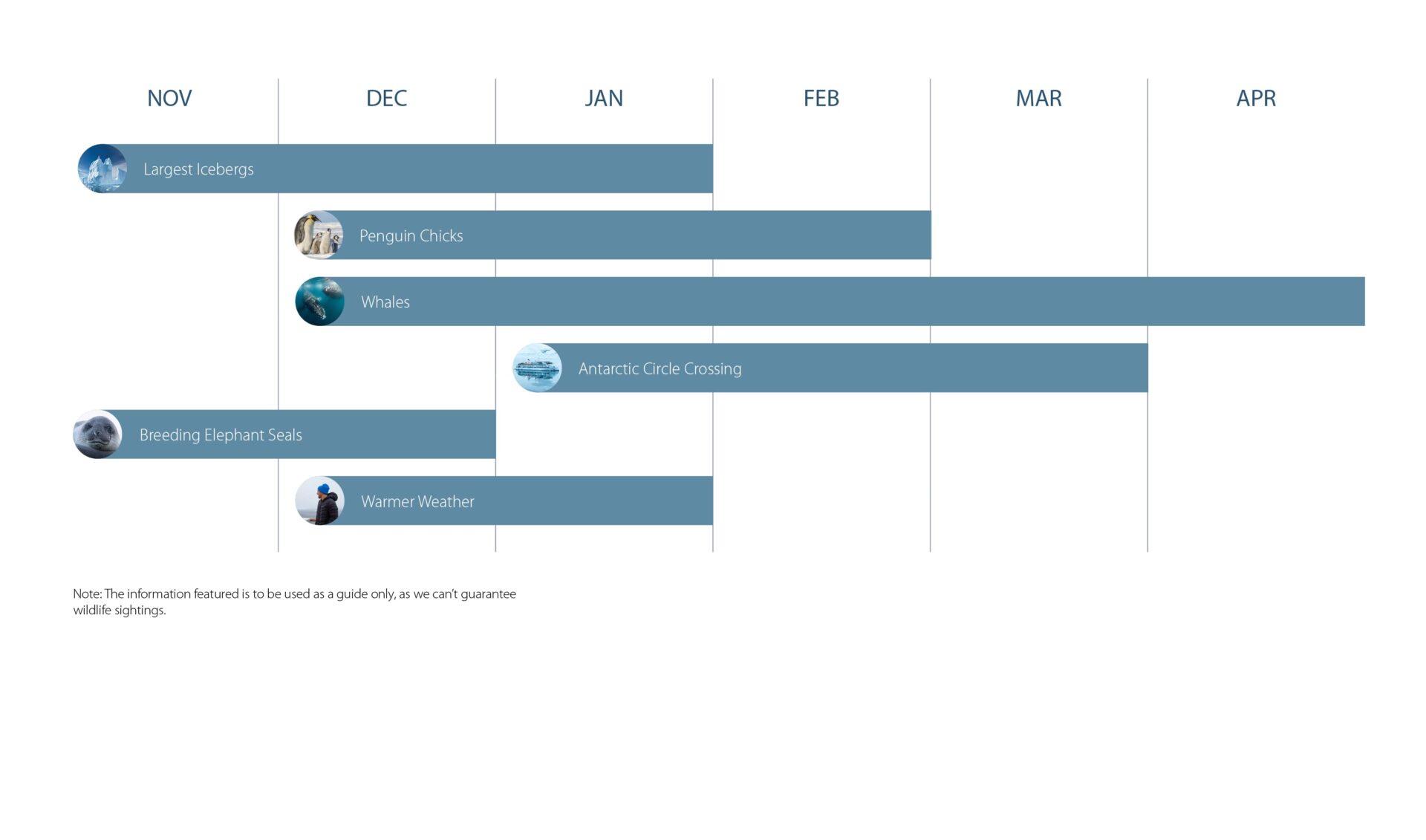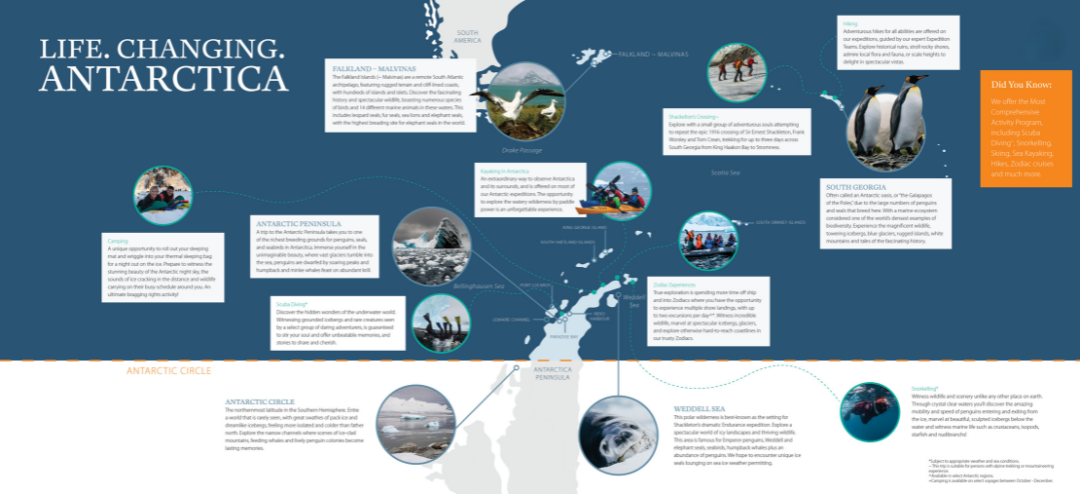Home > Destinations > Antarctica
Antarctica Cruises
Imagine a place so pristine and remote you can hear snowflakes hitting the water
“I would advise anyone with the smallest inkling or desire to visit Antarctica to just do it!” says Ruth T. “My trip was born from an off-the-cuff comment to my husband. After four years of planning and saving, we made it happen and celebrated our wedding anniversary in Antarctica.”
“I thought I’d never get the chance to visit Antarctica,” says Rachel B. “I did and it was worth every cent. The landscape, the flora and the fauna. Words cannot explain the experience I had. If you’ve ever thought about it just do it!”
Take a look around at our 2024-25 Antarctica itineraries below then request a booking and let us help you start planning your dream trip. Your Antarctic expedition begins here!
Antarctic Peninsula
South Georgia
Falklands~Malvinas
Weddell Sea
Antarctic Circle
Best Time To Go

Explore Antarctica
Antarctica Cruises FAQs
Antarctica is the southernmost continent on Earth. The South Geographic Pole is in Antarctica, and most of the continent lies within the Antarctic Circle, at 66.5 degrees south of the Equator.
Antarctica is so far south that most of the continent receives 24 hours of daylight during summer, and 24 hours of darkness during winter.
Antarctica lies to the south of Australia, New Zealand, South Africa and South America, and is surrounded by the Southern Ocean (also known as the Antarctic Ocean). Most visitors access Antarctica via ship or aircraft from an Antarctic ‘gateway city’. The five official Antarctic gateway cities are Ushuaia (Argentina), Hobart (Australia), Punta Arenas (Chile), Christchurch (New Zealand), and Cape Town (South Africa).
The name ‘Antarctica’ comes from ‘Antarktos’, meaning ‘opposite the Arctic’. Antarctica and the Arctic are indeed opposites in many ways, and they lie at the polar extremes of the globe: the Arctic to the north and Antarctica to the south.
Antarctica is home to a hardy community of wonderful wildlife, which has adapted to the cold, windy and icy Antarctic environment.
There are four species of penguins in Antarctica. They are the emperor, Adélie, gentoo and chinstrap. The emperor and Adélie penguins are found only in Antarctica.
There are six species of Antarctic seals: Ross seals, Weddell seals, crabeater seals, leopard seals, southern fur seals and southern elephant seals. They all live in the ocean surrounding Antarctica, hauling out on ice or land to rest and pup.
Many whales visit Antarctic waters during the summer feeding season between late October and early April. The whales that commonly visit Antarctic waters include humpback whales, killer whales, minke whales, fin whales, sei whales and even the enormous blue whale!
In addition to these charismatic creatures we see on the ocean’s surface, the Antarctic ocean is filled with a rich variety of sea life, from single-celled algae, which form the foundation of the Antarctic food web, to krill, a tiny crustacean which is a keystone species in the Antarctic ecosystem, providing sustenance for seals, whales, penguins and many other seabirds.
Most animals that thrive in Antarctica are marine animals. This means that they rely on the ocean and marine ecosystems to survive and thrive. However, there are a few Antarctic animals that live entirely on land. These include the microscopic springtails, nematodes and tardigrades, which live amongst moss and lichen in areas which are not permanently snow-covered.
Antarctica cruises typically range from 9 to 21 days, with most falling within the 10 to 14-day window. The specific length of your Antarctica cruise hinges on variables like the departure location and the chosen itinerary.
The cost of an Antarctica cruise can vary significantly, influenced by factors such as voyage duration, cabin type, and the chosen itinerary.
When considering an Antarctica cruise with Aurora Expeditions, you can expect prices to start from approximately $12,500 USD per person when sharing a twin Aurora Stateroom. For a comprehensive breakdown of what’s included in your Antarctica cruise, click here.
Undoubtedly, an Antarctica cruise offers a once-in-a-lifetime opportunity to behold the unspoiled beauty of the frozen continent, unique wildlife encounters, and breathtaking landscapes.
For many travellers, embarking on an Antarctica cruise fulfils a lifelong dream and proves to be an experience beyond their wildest expectations.
Antarctica is the coldest continent on Earth. The average temperature throughout the year is about -57°C, with the minimum temperature being -130°F (-90°C) during the winter season.
During the summer months, when we visit, the temperature can range from 28°F (-2°C) to 46°F (8°C). In summer, big storms are rare, but if one comes through the temperature could drop to 17°F (-8°C ). Read more about why austral summer is the best time to visit Antarctica.
Shipboard attire leans toward the informal and casual side, you’ll find jeans, jumpers, and long-sleeved shirts comfortable indoors. It’s wise to have your jacket within reach for impromptu wildlife encounters.
While there’s no need for formal clothing, some travellers like to dress up for the captain’s welcome and farewell drinks.
Each passenger on our Antarctic cruises will receive an expedition jacket. Though, you should pack suitable cold and wet weather gear for onshore landings during your Antarctica cruise.
To help you prepare, consult our suggested packing list, which outlines the recommended types of layers and materials for an Antarctica cruise.
For travellers based in Australia and New Zealand, you can reach Antarctica from the southern tip of South America. Two popular departure points for Antarctica cruises are Ushuaia, Argentina, and Punta Arenas, Chile, both located in the Patagonian region and are among the southernmost towns on Earth.
Antarctica cruises commencing in Ushuaia typically involve crossing the Drake Passage to reach the Antarctic Peninsula or voyaging to the Subantarctic Islands of the Falklands or South Georgia before continuing onward to Antarctica.
Alternatively, passengers departing from Punta Arenas can enjoy a unique experience by flying to Antarctica, specifically King George Island, via a charter flight arranged exclusively for their expedition.
Explore further details on how to access Antarctica.
The best time to embark on an Antarctica cruise falls within the austral summer, spanning from early October to late March. The Antarctic winter season is characterised by harsh cold and extended darkness, with the continent encircled by a vast expanse of sea ice that nearly doubles its size. Many wildlife species migrate north, and the Antarctic Peninsula becomes inaccessible.
As summer emerges, Antarctica comes alive with the return of the sun, ushering in huddles of penguins, pods of whales, and herds of seals. During this season, sea ice either dissipates or drifts away from the Antarctic Peninsula’s coastline, granting expedition vessels access to numerous sheltered bays and harbours where you can witness the splendour of the frozen continent.
Travellers should consult with their healthcare providers to ensure they are physically prepared for their Antarctica cruise.
It’s mandatory for each passenger to complete a Medical Form, to be signed by your general practitioner and submitted to Aurora Expeditions no later than three months and no earlier than six months before your voyage departure date.
If you become aware of any changes in your health or fitness that might affect your participation in the Antarctica cruise, (e.g. pregnancy, mental illness, heart or bronchial conditions, broken limbs, etc/), you should promptly notify us in writing.
For those concerned about seasickness during their Antarctica cruise, we recommend speaking to a medical professional. We recommend arriving prepared with motion sickness tablets. Rest assured that a doctor will be available onboard to provide assistance with any seasickness concerns.
Travellers must adhere to environmental protection guidelines and practice responsible tourism to safeguard Antarctica’s delicate ecosystem throughout their cruise.
Children are more than welcome on our Antarctica cruises. However, we recommend that they are at least 8 years old and must travel with their legal guardian. Children pay the same rate as an adult traveller.



